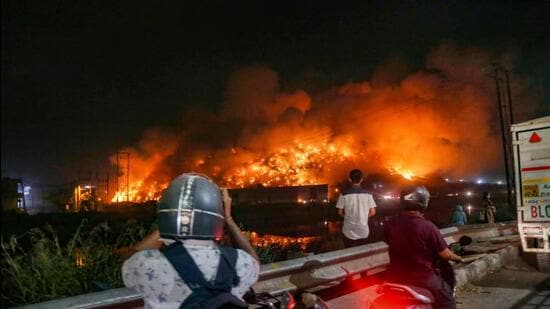
Reasons why waste dump locations in Delhi are going up in flames
Non-segregation of waste, lack of non-combustible material layers in landfills and summer heat are some of the causes for starting fires

Frequent fires in landfills around cities are a glaring example of the country’s perpetual struggle to manage its refuse and stop illegal dumping of waste.
The massive fire at the Bhalswa landfill in north Delhi is just one of the four such incidents reported in the national capital this month. The other three were reported at the Ghazipur landfill site in east Delhi. The Bhalswa landfill site reported 12 fire cases in 2021 and this one is the third this year.
The Dadumajra landfill site on the periphery of Chandigarh was also in the news recently for going up in flames. The place has caught fire 486 times in the last 15 years. About 50,000 people live in the close vicinity of Dadumajra and they frequently complain of bad smell and polluted air after the fire.
Behind the woes
Inefficient garbage processing is at the heart of this ever-increasing problem. India generates about 62 million tonnes of waste annually, states the Ministry of Environment, Forest and Climate Change data for 2016. Of this, only about 75% of the municipal waste gets collected and only 22-28% of this waste is processed. The rest ends up in dumps.
The Centre for Science and Environment in Delhi, a non-profit, found in 2020 that the country has more than 3,000 mountainous landfills containing 800m tonnes of rubbish. The country’s tallest mountain of rubbish – in Mumbai – is estimated to be 18 storeys high.
An official of Chandigarh Pollution Control Board (CPCC) told Mongabay-India that the fires are very common at dumpsites especially during summer because of the methane gas trapped inside. The dumpsite, he added, is a perfect breeding ground for methane due to decomposition of biodegradable or food waste over time and it quickly catches fire when it comes into close contact with anything combustible. Potential of catching fire increases in summer because of high temperatures.
The Solid Waste Management Rules issued by the Centre in 2016 state that only non-recyclable, non-biodegradable and non-combustible waste should go to a dumpsite. However, hundreds of tonnes of biodegradable and combustible waste are still dumped at the site every day. The mountains of refuse are a result of years of dumping without segregation and processing.
Also read: Delhi govt makes masks mandatory again; schools to remain open
The solution
A Delhi fire brigade official suggested using construction waste to create layers of non-combustible materials so that the fire doesn’t spread. “The corporation should dump an inert layer of sand and construction waste after every layer of freshly dumped waste. Such layers act as barriers against the fire,” the official said.
Segregation of waste into degradable and non-degradable categories is essential to reduce the load at landfill sites. However, years of government campaigns have yielded little result.
Kailash Shishupal, an advocate of sustainable living and a conservationist, says the problem lies with the way we look at waste. “If you ever visit a landfill site do see closely what lies dumped inside. There are so many things which can be easily reused, like old clothes. And then there are many more things that can be recycled like electronic goods, thick plastic, glass, tin etc. Plastic below 50 microns is the real nuisance while leftover eatables paints a shoddy picture of the way we actually treat food, considered equivalent to Lord Brahma,” said Shishupal.
Amit Sharma of Chandigarh filed a PIL on Dadumajra in high court last year. He told Mongabay-India that there are only two ways this problem can be handled. First, is to clear whatever quantity of waste is laying in the existing dumpsite, also called legacy waste. Second is to ensure that daily generation of garbage is 100% processed after segregation and it does not pile up on the site.
Also read: Ghazipur landfill fire: NGT likens dump sites in Delhi to time bomb
The municipal authorities should focus on prevention, reduction, reuse and recycling.
Recent incidents
The first significant fire this summer was reported at Ghazjpur on March 28. The fire continued for three days, with thick fumes billowing from the burning grounds into areas of Ghazipur, Kondli, Patparganj, IP Extension, Kaushambi and Khoda in Delhi and neighbouring Uttar Pradesh. Two more blazes were reported at the site on April 10 and April 20.
The fire at Dadunajra dumping site in Chandigarh started on April 7, engulfing the surrounding areas in thick smog. Similar incidents were reported at the site last year and enveloped at least half of Chandigarh, hindering visibility and causing respiratory problems.
Two days back, a scrapyard in Manesar, Gurugram, caught fire. It is believed that strong winds carried this fire to the nearby slums, where the situation worsened following the explosion of gas cylinders. The incident led to the death of a woman, who was burnt alive, while also injuring five adults and a child.


